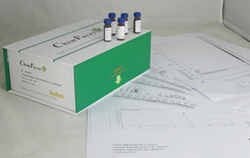Hot Products



| Catalog No. | Information |
| CFN92560 | Peucedanocoumarin III Peucedanocoumarin Ⅲ can induce rice resistance to blast disease. |
| CFN99738 | Peucedanol (R)-peucedanol has radical scavenging on 1,1-diphenyl-2-picrylhydrazyl radical and for inhibition of oxidation of liposome induced by 2,2'-azobis(2-amidinopropane) dihydrochloride, it may have antioxidant activity. |
| CFN89412 | Peucedanol 7-O-glucoside Reference standards. |
| CFN95272 | Peucenidin |
| CFN93412 | Peujaponiside Reference standards. |
| CFN98611 | Phaseollidin Phaseollidin, a phytoalexin from Phaseolus vulgaris, has antimicrobial activity. It also has anti-anxiety properties. |
| CFN97946 | Phaseollin Phaseollin and neorautenol may be responsible for the anticarcinogenic actions of the plant extract, may lead to new pharmacons to be used in cancer therapy.9-Aminoacridine and other DNA intercalators function as inducers of Phaseollin and phenylalanine ammonia lyase synthesis by reacting with the DNA template.The red kidney bean phytoalexins kievitone and phaseollin possess both estrogenic and antiestrogenic activities. |
| CFN97118 | Phebalosin Phebalosin displays 50% effective concentrations (EC(50)) of 14.1 microg/mL against axenic amastigote forms of Leishmania panamensis. It also displays cytotoxicity (IC(50)) at concentrations of 20.7 microg/mL on human promonocytic U-937 cells. |
| CFN98863 | Phellamurin Phellamurin inhibits intestinal P-glycoprotein in a dose-dependent manner, there is a serious interaction occurred between Phellamurin with cyclosporin, to ensure the efficacy of cyclosporin, we suggest that the coadministration of Phellamurin or Phellodendron wilsonii with cyclosporin should be avoided. |
| CFN99143 | Phellodendrine Phellodendrine has the effect of suppressing cellular immune response, reducing blood pressure and antinephritis, it also has antioxidant, and anti-inflammatory effects. Phellodendrine can suppress local semisyngeneic GvH reactions and systemic allogeneic GvH reactions in X-ray irradiated recipient mice, it also can suppress the induction phase of sheep red blood cell (SRBC)-induced delayed type hypersensitivity in mice and tuberculin-induced delayed type hypersensitivity in guinea pigs, Phellodendrine can down-regulating AKT, IKK, NF-kB phosphorylation and COX-2 expression induced by AAPH, it also ameliorates the ROS-mediated inflammatory response. |